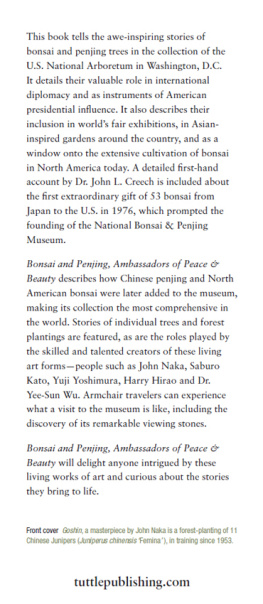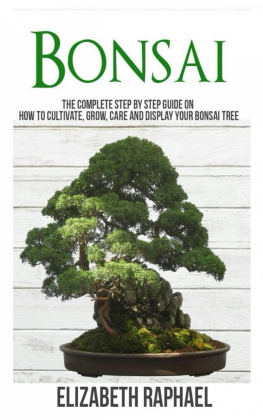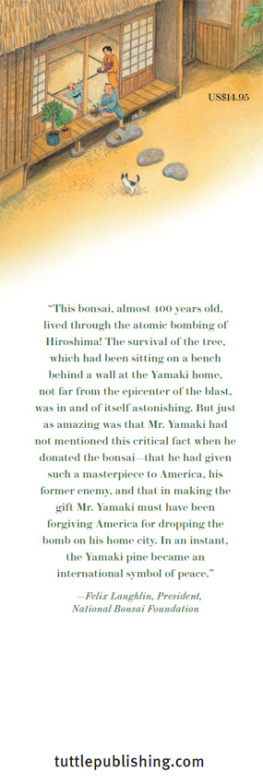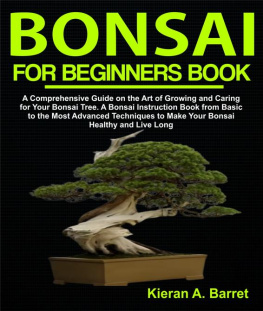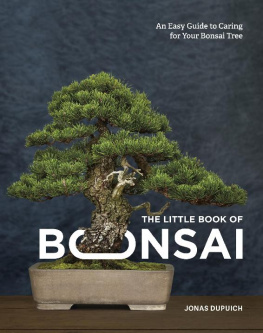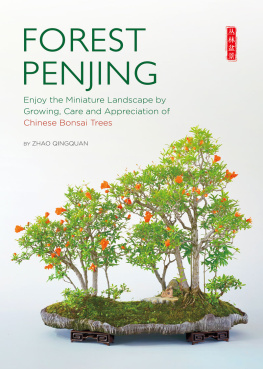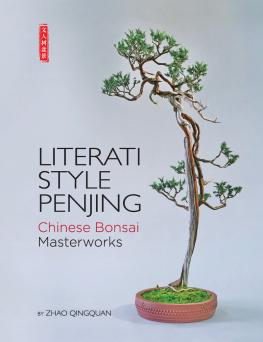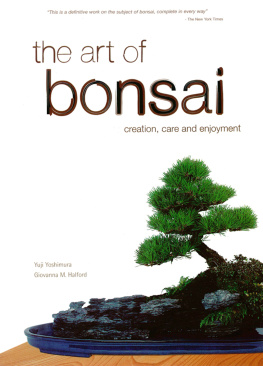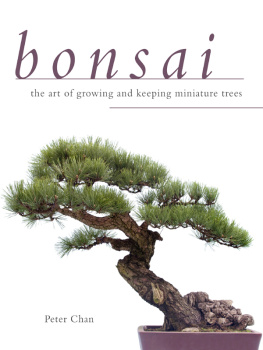Acknowledgments
I am profoundly grateful to the many people who devoted their time, talent and expertise toward making this book possible. First and foremost, Jack Sustic of the National Bonsai & Penjing Museum, Dr. Johann Klodzen of the National Bonsai Foundation, and Kathleen Emerson-Dell of the U.S. National Arboretum shared their knowledge and provided assistance above and beyond the call of duty. The commitment of the National Bonsai Foundation Board of Directors, led by President Felix Laughlin, made this book possible, as did the support of the U.S. National Arboretums former Director, Dr. Colien Hefferan, and current Director, Dr. Richard Olsen.
Deep gratitude is due the many others who went out of their way to provide assistance, especially Masato Otaka and Yoko Tsuge of the Japanese Embassy; Susan Fugate, Rachel Donahue, and Diane Wunsch and their colleagues at the National Agricultural Library Special Collections; Kathy Crosby of the Brooklyn Botanic Garden; Arielle Simon of the Fairchild Tropical Botanic Garden; Betsy Kohut of the Freer Gallery of Art and Arthur M. Sackler Gallery; William Valavanis of International Bonsai; Doug Kale of Kales Nursery and Landscaping; Hoichi Kurisu of Kurisu International; Felix Laughlin; Katherine Blood and Mari Nakahara of the Library of Congress; Rachel High of the Metropolitan Museum of Art; Dawn Bonner of Mount Vernon; Kirk Delman of Scripps College; Andrew Colligan of the Missouri Botanical Garden; and Ryan Pettigrew of the Richard Nixon Presidential Library and Museum. Closer to home, special thanks are due to former National Arboretum employees Robert Drechsler, Nancy Luria and Aarin Packard, and to the many contributors to the NBF Bulletin , an invaluable resource about the national bonsai collections for future generations.
A heartfelt thank you to those whose expertise brought a flotsam of images and text together to make the beautiful volume you hold in your hands: June Chong, Chan Sow Yun and the creative team at Tuttle Publishing. Special thanks to Chang Lee of ABC Graphics for photo editing, to Christopher Johns of Tuttle Publishing for expressing interest, and to Deborah Ziska for the initial idea.
Last though hardly least, I thank the bonsai and penjing in the U.S. national collections for teaching me the profound truth of John Nakas wise words, often quoted by Jack Sustic, Bonsai is not you working on a tree. It is the tree working on you.
Ann McClellan
About Tuttle
Books to Span the East and West
Our core mission at Tuttle Publishing is to create books which bring people together one page at a time. Tuttle was founded in 1832 in the small New England town of Rutland, Vermont (USA). Our fundamental values remain as strong today as they were thento publish best-in-class books informing the English-speaking world about the countries and peoples of Asia. The world has become a smaller place today and Asias economic, cultural and political influence has expanded, yet the need for meaningful dialogue and information about this diverse region has never been greater. Since 1948, Tuttle has been a leader in publishing books on the cultures, arts, cuisines, languages and literatures of Asia. Our authors and photographers have won numerous awards and Tuttle has published thousands of books on subjects ranging from martial arts to paper crafts. We welcome you to explore the wealth of information available on Asia at www.tuttlepublishing.com.
Bibliography
Albek, Morten with Wayne Schoech, Majesty in Miniature, Shohin Bonsai, Unlocking the Secrets of Small Trees. Passumpsic, Vermont: Stone Lantern Publishing, 2007.
Albert, Karin, Mountains and Water in Chinese Art. Bonsai Clubs International , September/October 1988, Volume XXVII, No. 5.
_______, Rocks and Rock Landscapes. Bonsai Clubs International , September/October 1988, Volume XXVII, No. 5.
Allinson, Mary, A Short History of Tiny Trees. Longwood Gardens Blog, June 9, 2015.
Baran, Robert J., Bonsai Book of Days. www.phoenixbonsai.com.
Becker, Rachel A., This Bonsai Survived Hiroshima But Its Story Was Nearly Lost. news.nationalgeographic.com, August 5, 2015.
Bloomer, Mary Holmes with photographs by Peter L. Bloomer, Timeless Trees, the U.S. National Bonsai Collection. Flagstaff, Arizona: Horizons West, 1986.
Brown, Kendall H., Quiet Beauty, The Japanese Gardens of North America . Tokyo, Rutland, Vermont, Singapore: Tuttle Publishing, 2013.
_______, Territories of Play: A Short History of Japanese-Style Gardens in North America. Japanese-Style Gardens of the Pacific West Coast, New York, Rizzoli, 1999.
Buchanan, Joy, John Y. Naka, 89; Brought Art of Asian Bonsai to West. Los Angeles Times , May 24, 2004.
Cathey, Henry M., Growing Bonsai . Washington, D.C.: U.S. Department of Agriculture, Home and Garden Bulletin No. 206, 1977.
Chan, Peter, Bonsai Secrets, Designing, Growing and Caring for Your Miniature Masterpiece. Pleasantville, New York: The Readers Digest Association, Inc., 2006.
Chester-Davis, Leah, John L. Creech: A Giant in Plant Exploration. The Trillium , Vol. 24, Issue 2, MarchApril 2014.
_______, The Horticultural Legacy of John L. Creech. YouTube Presentation, JC Raulston Arboretum, May 21, 2014.
Choukas-Bradley, Melanie, City of Trees, The Complete Field Guide to the Trees of Washington, D.C. , Charlottesville and London: The University Press of Virginia, 2008.
Clark, Randy T., Outstanding American Bonsai. Portland, Oregon: Timber Press, 1989.
Covello, Vincent T. and Yoshimura, Yuji, The Japanese Art of Stone Appreciation, Suiseki and Its Use with Bonsai. Tokyo , Rutland, Vermont, Singapore: Tuttle Publishing, 2009.
Creech, Dr. John, The Bonsai Saga, How the Bicentennial Collection Came to America. Washington, D.C.: The National Bonsai Foundation, 2001.
Crutcher, Anne, Q and A, Devoting His Lifes Work to Arboretum. The Washington Star , September 5, 1976.
Del Tredici, Peter, Early American Bonsai: The Larz Anderson Collection of the Arnold Arboretum.
Jamaica Plain, Massachusetts: Arnold Arboretum of Harvard University, 1989.
_______, The Larz Anderson Collection of Japanese Dwarf Trees and the Early Importation of Chabo Hiba Hinoki Cypress into North America. Washington, D.C.: National Bonsai Foundation, Proceedings of the International Scholarly Symposium on Bonsai and Viewing Stones, May 2002.
Drechsler, Robert, telephone interview, July 13, 2015.
Durham, Sharon, State Departments Gift of Dogwoods to Japan in Honor of 100th Anniversary of Cherry Tree Gift. Agricultural Research , February 2013.
Elias, Thomas S., History of the Introduction and Establishment of Bonsai in the Western World. Washington, D.C.: National Bonsai Foundation, Proceedings of the International Scholarly Symposium on Bonsai and Viewing Stones, May 2002.
Elias, Thomas S. and Nakaoji, Hiromi, Chrysanthemum Stones, The Story of Stone Flowers. Warren, Connecticut: Floating World Editions, 2010.
Forgey, Benjamin, Capitols Columns Moved to Arboretum. The Washington Post , June 27, 1984.
Fukumoto, David W., The Many Facets of Chinese Bonsai. Bonsai Clubs International , September/ October 1988, Volume XXVII, No. 5.
Funk, Brian and Schmidt, Sarah (eds), Japanese-Style Gardens. Brooklyn, New York: Brooklyn Botanic Garden, 2015.
Gillette, Felix, The Education of Little Trees, Day by Day, Twig by Twig, National Bonsai and Penjing Museum curator Warren Hill trains a remarkable collection of tiny timber. www.washingtoncitypaper.com, April 6, 2001.
Gustafson, Herb L., Miniature Bonsai. New York: Sterling Publishing Co. Inc., 1995.
Hammer, Elizabeth, A Closer Look, Nature Within Walls, The Chinese Garden Court at the Metropolitan Museum of Art. New York: The Metropolitan Museum of Art, 2003.

